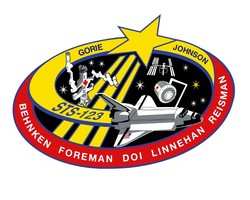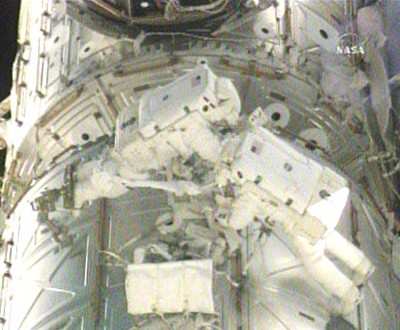Combined STS-123, ISS Crew Prepares For Last Spacewalk
 The verdict is still out
on whether a new heat-shield tile repair method will prove to be
the kind of solution NASA has been looking for... but early results
are very promising.
The verdict is still out
on whether a new heat-shield tile repair method will prove to be
the kind of solution NASA has been looking for... but early results
are very promising.
As ANN reported, Mission
Specialists Michael Foreman and Robert Behnken tested the new
procedure Thursday, during the fourth of five planned spacewalks
during the shuttle Endeavour's extended stay at the ISS. As part of
the 6 1/2-hour excursion, the two men used a device similar to a
high-tech caulk gun to insert ablative putty into cracks on a
sample tile, then using a brush to smooth the material out.
The 'goo' later solidifies into a plastic-like material, reports
The Associated Press, which NASA hopes will prove to be able to
withstand the heat generated during reentry. "We are absolutely
captivated by what you guys are doing here," Mission Control
radioed the spacewalkers during Thursday's test. "You're like brain
surgeons up there."
While the new method is similar to previous repair attempts --
which have yielded mixed results -- NASA hopes the new material
will be resistant to what the agency dubs the 'rising bread-loaf'
effect... in which bubbles form in the material, causing it to
swell out from the repair site. STS-123 lead spacewalk officer
Zebulon Scoville says so far, the results are encouraging.
"We're just thrilled with the way it turned out," he said,
adding final results must wait until the sample is tested on
Earth.
Even if the material proves successful, however, it will fall
short of being a silver-bullet solution for the kind of damage that
led to the 2003 loss of Columbia on reentry. Currently, the repair
material is only intended for the silica tiles on the shuttle's
underside, and other surfaces exposed to lower heat levels than the
reinforced carbon panels lining the leading edges of the shuttle's
wings... where damage doomed Columbia.
In related news, on Friday the crew checked Endeavour's wings
and nose for signs of micrometeorite damage that may have occurred
during the orbiter's stay at the station. That test is usually done
after a shuttle undocks from the ISS, but the 100-foot Orbiter Boom
Sensor System (OBSS) mounted to Endeavour's robotic arm will have
to be left behind at the station, for the crew of STS-124 to use
later this year... as every nook and cranny in Discovery's cargo
bay will be occupied by the second segment of the Japanese Kibo
module.

The Expedition 16 and STS-123 crews spent the remainder of
Friday configuring tools and reviewing procedures for the
flight’s final spacewalk. This includes the standard "camp
out" in the station’s Quest airlock, during which the
nitrogen is purged from the bodies of spacewalkers before they
enter the void of space.
Behnken and Foreman will begin that spacewalk at 1723 EDT
Saturday. Their tasks include stowing the OBSS on the
station’s S1 Truss, where it will be picked up by the STS-124
crew aboard space shuttle Discovery, set to launch in May.
Endeavour is scheduled to undock from the station Monday, and
return to earth at 2035 EDT March 26.
 NTSB Final Report: Cessna 177B
NTSB Final Report: Cessna 177B ANN's Daily Aero-Term (05.08.25): Final Approach Fix
ANN's Daily Aero-Term (05.08.25): Final Approach Fix Aero-News: Quote of the Day (05.08.25)
Aero-News: Quote of the Day (05.08.25) ANN's Daily Aero-Term (05.09.25): Estimated (EST)
ANN's Daily Aero-Term (05.09.25): Estimated (EST) ANN's Daily Aero-Linx (05.09.25)
ANN's Daily Aero-Linx (05.09.25)




